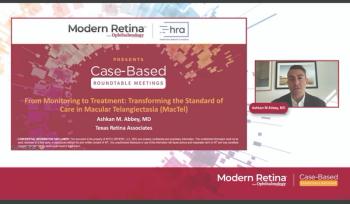
CTS 2024: Faricimab vs aflibercept in the reduction of exudates in Y/R trials
Jennifer Lim, MD, FARVO, spoke with us about her presentation Faricimab vs aflibercept in the reduction of exudates in Y/R trials" at Clinical Trials at the Summit meeting in Park City, Utah on June 8, 2024.
Jennifer Lim, MD, FARVO, spoke with us about her presentation, "Faricimab vs aflibercept in the reduction of exudates in Y/R trials" at Clinical Trials at the Summit meeting in Park City, Utah on June 8, 2024.
Video Transcript:
Editor's note: The below transcript has been lightly edited for clarity.
David Hutton:
I'm David Hutton of Ophthalmology Times, Clinical Trials at the Summit is being held in Park City, Utah. Dr. Jennifer Lim is making a presentation at the event. And she's joining us here today. Can you tell us about the key points in your presentation and their implications in ophthalmology?
Jennifer Lim, MD, FARVO:
Yes, it's my pleasure to be here today. Thank you so much for having me. Today, I discussed the fact that hard exudates can reduce quite significantly in patients who are treated with faricimab, more so than patients who are treated with aflibercept. And we do know that in eyes with diabetic macular edema, that hard exudates are really a biomarker for the amount of fluid and leakage that is occurring in eyes with diabetic macular edema. In the past treatments such as laser and steroids and anti VEGF have shown that you can reduce the hard exudates with treatment. So we were curious to see whether faricimab as compared to aflibercept could result in greater reductions in the hard exudates. Since other biomarkers that we've studied, have shown that the fluid can go away faster with faricimab compared to aflibercept two milligrams, and in fact that it can result in decreased leakage in terms of fluorescein angiography also as compared to aflibercept. And in fact, when we looked at the data, we found that at baseline, 81% of eyes had hard exudates. When we then looked at the head to head comparisons, in the beginning of the treatments, we saw that both drugs did reduce the amount of central subfield thickness, and did improve visual acuity as expected, as compared to the entire cohort.
Now, what was interesting is that for both groups, if patients had hard exudates, the amount of reduction in the CST, and the amount of improvement in visual acuity was slower than in eyes that did not have heart exudates at baseline. However, when we then looked at one year, we saw that these eyes with hard exudates did catch up to the group that did not have hard exudates. That is the visual acuity improved to similar extents, and the central subfield decreased to similar extents for both groups, respectively. Now, what was interesting was that when we compare the amount of eyes that had reduction in the presence of hard exudates, we found that there were more eyes in the faricimab group that had reduction, to no hard exudates present, as compared to eyes that were treated with aflibercept. So what this tells me is that there is another biomarker that is hard exudates that goes along with other biomarkers that we've studied, because we know that when we treat with faricimab compared to aflibercept two milligrams, we get faster drying, we get more reductions in the leakage, and so it makes sense that we also get reductions in the hard exudates.
David Hutton:
Ultimately, what could this mean for ophthalmologists and the patients they treat?
Jennifer Lim, MD, FARVO:
Well, you know, I think that when we have hard exudates that's really a sign that there's still continued leakage of fluid that's going on. And I think it's always better for the eyes to not have hard exudates present. Now, this study really looked at the presence, or absence of hard exudates. It didn't look specifically at the volume of the hard exudates and so an eye that could have had a significant reduction in the volume of hard exudates if there were still hard exudates present at baseline it was counted as being still with hard exudates. So what we're now doing is we're looking at volumetric analyses of these using AI and trying to quantitate the amount of hard exudates that are present and see whether the reductions are significantly different between the two groups. And at first glance, it does appear that there is a significant quantitative difference also and we're going to further pursue that and give the analysis in the future.
Newsletter
Keep your retina practice on the forefront—subscribe for expert analysis and emerging trends in retinal disease management.












































